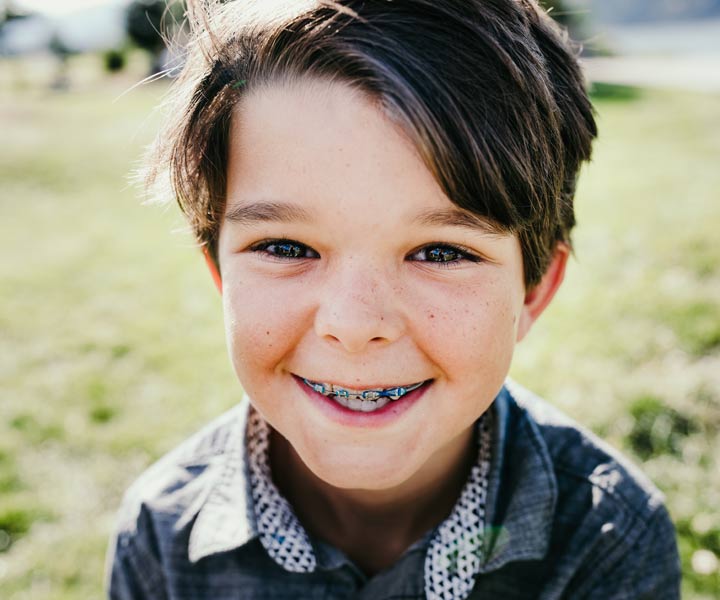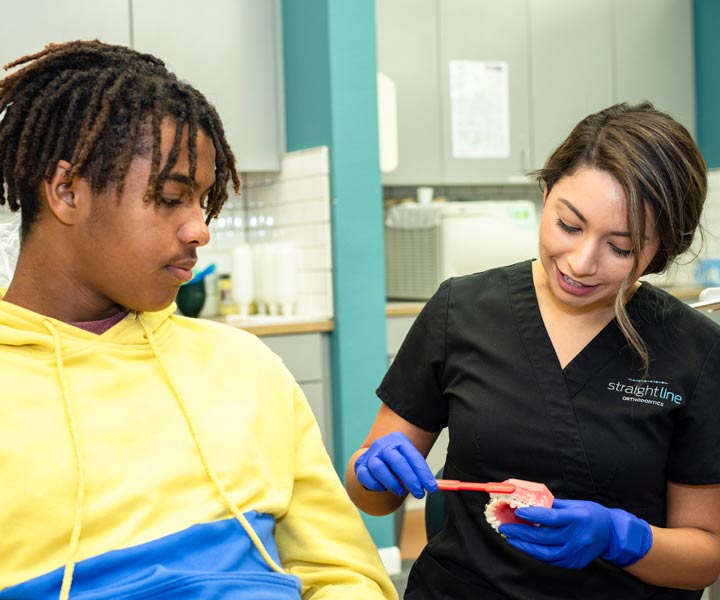phased treatment
The American Association of Orthodontists recommends that the initial orthodontic evaluation should occur around age 7. Treatment at this young age is usually not necessary but an exam can anticipate the most advantageous time to begin treatment.
Early treatment, or Phase I, typically begins around age 8 and lasts for approximately 12 months. It allows us to monitor and guide growth of the jaws if severe bite problems exist, such as overbites or underbites, or address specific problems that could be damaging to the teeth. Examples of Phase I treatment include expansion for crossbites, preserving space for crowded erupting teeth, or correcting harmful habits such as thumb sucking.
Comprehensive orthodontic (adolescent) treatment, or Phase II, typically begins at age 12 with the full permanent dentition and lasts an average of 24 months. Retainers are worn after this phase to ensure you retain a beautiful smile.
Get Started
adult braces
smile proud at any age.
Orthodontic treatment can be successful at any age and adults especially appreciate the benefits of a beautiful smile. 1 out of every 5 orthodontic patients are over the age of 21. The most common reasons for adults to seek orthodontic care is because of relapse from previous treatment as a child. Other reasons for treatment include: a bad bite (malocclusion); crowding or spacing that could be causing gum disease or tooth decay; worn or missing teeth that require movement for dental restorations. In more severe cases, jaw surgery or extractions may be necessary for adults because their jaws are not growing.
ceramic brackets
smile clear.
Our self-ligating ceramic brackets are made of a clear, translucent material that resist staining during treatment. They are usually used on older teenagers and adult patients who have cosmetic concerns. While visually less prominent, they are more brittle than their metal counterparts and tend to be used on upper teeth more than the lower teeth.
traditional braces
smile real.
Traditional metal braces are the most common type of braces. Made of high-grade stainless steel, metal braces straighten your teeth using metal brackets and archwires. Lots of kids wear their braces with pride and enjoy showing off their in-progress smile with Dr. Kara’s brightly colored elastics. We also offer “self-ligating” or tie-less brackets, reducing pressure on your teeth for more efficient movement. In addition to greater comfort, self-ligating brackets make it easier to maintain good oral hygiene, decrease frequency of visits, and shorten treatment time.
faqs
Handling Orthodontic Emergencies at Home
If I have braces do I still need dental check-ups every 6 months?
Do braces hurt?
How do I wear and take care of my retainers when I am finished with treatment?
- Wear your retainers full time, until the doctor instructs otherwise.
- Take your retainers out when eating and always put retainers in their case! (Most appliances are lost in school lunch rooms or restaurants.)
- Clean retainers thoroughly once a day with a toothbrush and toothpaste. Use warm but not hot water. Brushing retainers removes the plaque, and eliminates odors. Efferdent® or other orthodontic appliance cleaners can be used but do not take the place of brushing.
- When retainers are not in your mouth they should ALWAYS be in a retainer case. Pets love to chew on them!
- Initially, you may find it difficult to speak. Practice speaking, reading, or singing out loud to get used to them faster.
- Retainers are breakable, so treat them with care. If retainers are lost or broken, call us immediately.
- If you have any questions or concerns about your retainers, or your retainers need adjusting, call us. Do not try to adjust them yourself.
- Always bring your retainers to your appointments.
- Retainer replacement is expensive; with proper care they will last for years!
- Remove retainers when swimming.
- Keep retainers away from hot water, hot car dashboards, pockets, the washing machine, and napkins.





